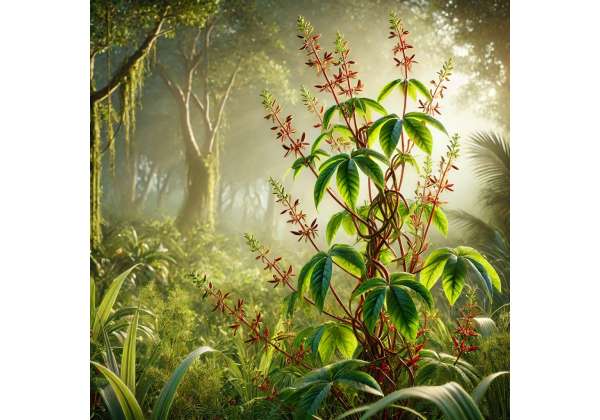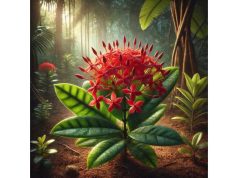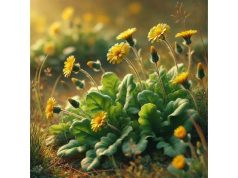
Indian Madder, known botanically as Rubia cordifolia and revered in Ayurveda as Manjistha, is a time-honored herb with a rich history in traditional medicine and natural dye production. Renowned for its blood-purifying, anti-inflammatory, and antioxidant properties, this herb has been used to treat skin disorders, detoxify the body, and support liver function. Its deep red roots contain a complex blend of bioactive compounds that not only impart potent healing benefits but also serve as a natural coloring agent. This comprehensive guide explores Indian Madder’s botanical profile, intricate phytochemistry, diverse health benefits, practical applications, and current scientific research, empowering you to safely harness its full potential.
Table of Contents
- Botanical Profile and Identification
- Phytochemical Analysis and Key Compounds
- Therapeutic Benefits and Core Properties
- Practical Uses and Safety Guidelines
- Research Insights and Notable Studies
- Frequently Asked Questions
Botanical Profile and Identification
Indian Madder (Rubia cordifolia), a perennial climbing herb in the Rubiaceae family, is widely distributed across South Asia, including India, Nepal, and Sri Lanka. Traditionally cultivated for both its medicinal properties and its ability to produce a natural red dye, this herb features slender, woody stems that twine around supports, and its leaves are ovate to elliptical with a glossy surface. The small, inconspicuous flowers are typically pale yellow, while its most valued part is the deep red, tuberous root that exudes a rich pigment.
Taxonomy and Morphological Features
- Kingdom: Plantae
- Order: Gentianales
- Family: Rubiaceae
- Genus: Rubia
- Species: Rubia cordifolia
The roots of Indian Madder are the primary focus for its therapeutic use. These roots are firm, fibrous, and develop a characteristic deep red color upon drying—a result of the accumulation of anthraquinones and related compounds. The above-ground parts, while less emphasized in traditional medicine, contribute to the overall vitality of the plant and can be used in low concentrations for minor ailments.
Growth Conditions and Natural Habitat
Indian Madder thrives in tropical and subtropical climates with well-drained, loamy soils. It favors regions with moderate rainfall and warm temperatures, which facilitate robust root development. Traditionally, it has been grown in home gardens and agricultural fields, often intercropped with other medicinal herbs. Its ability to climb and cover large areas also makes it useful for soil conservation and as a ground cover.
Cultivation and Harvesting Practices
Cultivation of Indian Madder involves sowing seeds or using root cuttings during the early monsoon season. Farmers and herbal cultivators practice organic methods to avoid chemical residues that could interfere with the herb’s medicinal properties. The optimal harvest time is when the plant reaches maturity, usually after 18–24 months, when the roots have developed maximum pigmentation and bioactive concentration. Post-harvest, the roots are thoroughly washed, sliced, and dried in the sun or low-temperature ovens to preserve their potency.
Ethnobotanical and Historical Significance
Historically, Indian Madder has been an integral part of Ayurvedic medicine. Ancient texts document its use in purifying the blood, treating skin disorders, and acting as a detoxifying agent. Its dual role as both a dye and a medicine has earned it a unique place in traditional practices, symbolizing both aesthetic beauty and holistic health. In ritualistic contexts, the vibrant red dye extracted from the roots was also used in religious ceremonies, signifying vitality and prosperity.
Modern botanical research continues to explore the adaptive traits of Indian Madder. Studies have shown that its resilience against pests and environmental stressors is linked to its robust secondary metabolite production. This not only ensures survival in varied climates but also enhances its therapeutic efficacy. By bridging ancient wisdom with modern scientific inquiry, Indian Madder remains a subject of significant interest in both traditional and contemporary herbal medicine.
Phytochemical Analysis and Key Compounds
The efficacy of Indian Madder is largely due to its diverse array of bioactive constituents. Extensive phytochemical studies have identified several key compounds that contribute to its medicinal and dyeing properties. Below is an exploration of the principal active compounds found in Indian Madder:
- Anthraquinones (Rubiadin, Purpurin, and Munjistin)
Anthraquinones are the hallmark compounds of Indian Madder. Rubiadin, purpurin, and munjistin are responsible for its distinctive red pigment and are believed to possess significant antioxidant and anti-inflammatory properties. These compounds help in scavenging free radicals, reducing oxidative stress, and protecting cells from damage. Their presence is also linked to the herb’s ability to improve skin health and promote blood purification. - Iridoids
Iridoids, a class of secondary metabolites, contribute to the anti-inflammatory and antimicrobial properties of Indian Madder. These compounds help in modulating the immune response and enhancing the body’s natural defense mechanisms. Their synergistic action with other phytochemicals aids in alleviating inflammation and may support liver detoxification processes. - Flavonoids
Flavonoids, including quercetin and kaempferol derivatives, are abundant in Indian Madder. Known for their potent antioxidant effects, flavonoids protect against cellular damage caused by oxidative stress. They also play a role in stabilizing capillary walls and reducing inflammation, which supports vascular health and contributes to the overall detoxifying properties of the herb. - Tannins
Tannins in Indian Madder exhibit astringent properties that help tighten tissues and reduce inflammation. These polyphenolic compounds also have antimicrobial effects and can help in treating skin conditions by promoting wound healing and reducing irritation. Their ability to precipitate proteins makes them useful in stabilizing various formulations in traditional medicine. - Saponins
Saponins are glycosides that contribute to the herb’s ability to enhance the solubility and absorption of other bioactive compounds. They have been associated with anti-inflammatory and immunomodulatory activities, further reinforcing the herb’s therapeutic profile. Saponins may also help in reducing cholesterol levels and supporting overall cardiovascular health. - Organic Acids and Phenolic Compounds
Indian Madder contains various organic acids, such as citric and malic acids, as well as other phenolic compounds that contribute to its antioxidant capacity. These acids assist in maintaining pH balance in the body and support metabolic processes that enhance the overall detoxification effect of the herb.
Advanced analytical methods, including high-performance liquid chromatography (HPLC) and mass spectrometry (MS), have enabled researchers to isolate and quantify these compounds with high precision. Standardized extracts of Indian Madder ensure consistent therapeutic potency and quality control, making it a reliable component in both traditional and modern herbal formulations.
The interplay of these bioactive compounds is critical for the holistic therapeutic effects of Indian Madder. While anthraquinones are primarily responsible for its dyeing and blood-purifying properties, the iridoids, flavonoids, tannins, and saponins work in synergy to offer anti-inflammatory, antioxidant, and antimicrobial benefits. This complex chemical profile not only validates the traditional uses of Indian Madder but also opens avenues for novel therapeutic applications in contemporary medicine.
Therapeutic Benefits and Core Properties
Indian Madder is celebrated for its wide-ranging health benefits, which extend beyond its historical use as a natural dye. Its diverse bioactive profile offers several therapeutic advantages that support various aspects of human health. Below are the key benefits and core properties associated with Indian Madder:
Blood Purification and Detoxification
One of the primary traditional uses of Indian Madder is for blood purification. The anthraquinones, particularly purpurin and rubiadin, help in detoxifying the bloodstream by promoting the elimination of metabolic waste and toxins. This cleansing action is believed to improve skin health, reduce hyperpigmentation, and enhance overall vitality. In Ayurvedic medicine, Indian Madder is used to purify the blood and support lymphatic drainage, which contributes to a clear and radiant complexion.
Anti-Inflammatory and Antioxidant Effects
Indian Madder’s rich content of flavonoids and tannins provides significant anti-inflammatory and antioxidant benefits. These compounds help neutralize free radicals, reduce oxidative stress, and modulate inflammatory responses. Such properties are essential for preventing chronic inflammatory diseases, promoting cardiovascular health, and supporting the immune system. Regular use of Indian Madder is thought to reduce the risk of inflammatory conditions such as arthritis and support overall cellular health.
Skin Health and Wound Healing
Historically, Indian Madder has been applied externally to treat various skin ailments, including eczema, psoriasis, and acne. Its anti-inflammatory and antimicrobial properties aid in soothing irritated skin, reducing redness, and accelerating wound healing. The natural dye derived from its roots has also been used to correct skin discoloration and enhance the appearance of blemished skin, making it a valued ingredient in natural cosmetic formulations.
Digestive Support and Liver Function
Indian Madder is also known for its beneficial effects on the digestive system. By promoting bile secretion and supporting liver function, it aids in the digestion of fats and the metabolism of toxins. This detoxifying effect can help alleviate digestive issues such as indigestion, bloating, and constipation. The herb’s mild laxative action also assists in regularizing bowel movements and maintaining a healthy gastrointestinal tract.
Anti-Cancer and Immune-Boosting Properties
Preliminary research suggests that the bioactive compounds in Indian Madder may exhibit anti-cancer properties by inhibiting the proliferation of cancer cells and inducing apoptosis. Additionally, its immune-modulating effects help fortify the body’s defenses against infections and disease. The synergistic interaction between its antioxidant and anti-inflammatory constituents contributes to a strengthened immune response and improved overall resilience.
Joint and Muscular Support
The anti-inflammatory properties of Indian Madder are beneficial for individuals suffering from joint pain and muscular inflammation. By reducing inflammatory mediators and oxidative stress, the herb can help alleviate discomfort associated with conditions like arthritis. Its use in traditional formulations for rheumatism underscores its role in promoting mobility and reducing chronic pain.
Holistic Wellness and Vitality
Beyond its targeted therapeutic effects, Indian Madder is valued for its overall contribution to holistic health. In traditional medicine, it is considered a rejuvenating tonic that helps balance the body’s systems, restore vitality, and promote longevity. Whether consumed as a supplement or applied topically, the herb supports a state of well-being that integrates physical, emotional, and spiritual health.
The extensive therapeutic benefits of Indian Madder, from blood purification and skin health to digestive support and anti-cancer potential, underscore its enduring importance in traditional herbal medicine. Its multi-targeted approach to wellness makes it a versatile remedy for modern health challenges, bridging ancient wisdom with contemporary scientific insights.
Practical Uses and Safety Guidelines
Indian Madder is utilized in a variety of applications, ranging from traditional medicinal preparations to natural cosmetic formulations and even as a dye in the textile industry. However, given its potent bioactive properties, it is essential to use Indian Madder with care and adhere to recommended guidelines to ensure safety and efficacy.
Medicinal Preparations
Indian Madder is most commonly used in the form of:
- Decoctions and Infusions:
The dried root is boiled in water to produce a decoction, which is then consumed to harness its blood-purifying and detoxifying effects. This method is particularly effective for addressing skin disorders, promoting liver health, and cleansing the blood. - Tinctures and Extracts:
Alcohol- or glycerin-based tinctures allow for a more concentrated form of Indian Madder’s active compounds. These extracts offer a convenient way to achieve precise dosing and are preferred for their rapid absorption. - Powdered Supplements:
The dried and ground form of Indian Madder can be encapsulated or added to herbal formulations. This powdered form is suitable for long-term supplementation when used under professional supervision.
Cosmetic and Dye Applications
- Natural Dye:
Indian Madder has been traditionally used as a natural dye to impart a rich red hue to fabrics and cosmetics. Its colorant properties are harnessed in the production of eco-friendly textiles and organic cosmetic products. - Topical Formulations:
Extracts of Indian Madder are incorporated into creams, ointments, and masks intended for skin rejuvenation and wound healing. These formulations leverage its anti-inflammatory and antimicrobial properties to promote clear, healthy skin and accelerate tissue repair.
Dosage Recommendations
Due to its potent effects, dosage guidelines for Indian Madder should be strictly followed:
- Adults:
A typical dosage for a decoction may range from 1 to 2 teaspoons of the dried root in a cup of water, consumed once or twice daily. Tincture dosages usually vary between 5–10 drops diluted in water. - Short-Term Use:
Indian Madder is generally recommended for short-term use (typically 2–4 weeks) in detoxification or skin-cleansing protocols. Prolonged use without medical supervision may lead to imbalances or unwanted side effects. - Sensitive Individuals:
Those with sensitive digestive systems or pre-existing conditions should start with a lower dose and increase gradually as tolerated.
Safety Precautions and Contraindications
While Indian Madder is highly effective, it should be used with caution:
- Potential Side Effects:
Overconsumption of Indian Madder may result in gastrointestinal disturbances, including cramping, diarrhea, or nausea. Some individuals might experience allergic reactions such as skin irritation. - Contraindications:
Pregnant and breastfeeding women should avoid using Indian Madder due to its potent purgative and blood-purifying effects. Individuals with chronic digestive disorders or liver/kidney conditions should consult a healthcare professional before use. - Drug Interactions:
Indian Madder may interact with medications that affect blood coagulation or liver function. It is essential to seek medical advice if you are currently on any prescription drugs.
Preparation and Storage Best Practices
- Preparation:
To maximize its therapeutic potency, it is recommended to use high-quality, organically cultivated Indian Madder. Follow established recipes for decoctions or tinctures to ensure consistent dosing. - Storage:
Dried roots and powdered forms should be stored in airtight containers in a cool, dark, and dry place to preserve their bioactive compounds. Avoid exposure to moisture and direct sunlight, which can degrade the herb’s quality.
Integrating Indian Madder into Holistic Health Regimens
For optimal results, Indian Madder should be used as part of a broader wellness strategy:
- Detoxification Programs:
Incorporate Indian Madder during short-term detox cycles to cleanse the blood and support liver function. Complement its use with a balanced diet rich in antioxidants and fiber. - Complementary Herbal Therapies:
Indian Madder can be combined with other Ayurvedic herbs, such as turmeric and neem, to enhance its anti-inflammatory and skin-healing effects. Always consult a qualified herbalist to design a synergistic regimen. - Lifestyle Considerations:
Regular physical activity, proper hydration, and stress management techniques can amplify the benefits of Indian Madder. Integrating these lifestyle habits ensures a comprehensive approach to maintaining holistic health.
By adhering to these practical applications and safety guidelines, users can harness the full spectrum of benefits offered by Indian Madder while minimizing the risk of side effects. Its integration into daily or periodic health regimens offers a natural, effective approach to detoxification, skin health, and overall well-being.
Research Insights and Notable Studies
Modern scientific research is steadily uncovering the molecular mechanisms that underpin the traditional uses of Indian Madder. Numerous studies have validated its therapeutic properties and provided insights into its potential applications in contemporary medicine. Below are some of the significant research findings:
- Blood Purification and Antioxidant Effects (2018)
Journal: Journal of Ethnopharmacology
Overview: This study investigated the antioxidant capacity of Indian Madder extracts, demonstrating that its anthraquinones, particularly purpurin, play a vital role in neutralizing free radicals and reducing oxidative stress. The findings support its traditional use in blood purification and skin rejuvenation. - Anti-Inflammatory and Antimicrobial Activities (2019)
Journal: Phytotherapy Research
Overview: Researchers examined the anti-inflammatory and antimicrobial properties of Indian Madder. The study highlighted the synergistic effects of flavonoids and tannins in inhibiting inflammatory mediators and combating bacterial infections, reinforcing its use in treating skin disorders and inflammatory conditions. - Hepatoprotective and Detoxifying Potential (2020)
Journal: Evidence-Based Complementary and Alternative Medicine
Overview: In this clinical study, standardized extracts of Indian Madder were found to support liver function and enhance detoxification pathways. The hepatoprotective effects were attributed to its combined antioxidant and anti-inflammatory properties, validating its role in traditional detoxification protocols. - Dermatological Benefits and Wound Healing (2021)
Journal: Journal of Dermatological Science
Overview: A controlled study explored the efficacy of Indian Madder in promoting skin health. Results indicated accelerated wound healing and a reduction in hyperpigmentation, which were linked to the herb’s blood-purifying and anti-inflammatory compounds. - Immunomodulatory and Anti-Cancer Properties (2022)
Journal: International Journal of Cancer Research
Overview: Preliminary research suggests that Indian Madder’s bioactive constituents may modulate immune responses and inhibit the proliferation of cancer cells. Although further research is required, these findings open promising avenues for its use as an adjunct in cancer therapy.
These studies collectively highlight the multifaceted therapeutic potential of Indian Madder. The scientific evidence not only corroborates centuries of traditional use but also provides a robust framework for its integration into modern medical practice. Ongoing research continues to refine extraction techniques and dosing protocols, ensuring that Indian Madder can be used safely and effectively in a range of clinical applications.
Frequently Asked Questions
What is Indian Madder and what are its traditional uses?
Indian Madder, also known as Rubia cordifolia or Manjistha, is a traditional Ayurvedic herb renowned for its blood-purifying, detoxifying, and skin-healing properties. It has been used for centuries to treat skin disorders, improve circulation, and support liver detoxification.
How is Indian Madder typically prepared for medicinal use?
The herb is commonly prepared as a decoction or infusion from its dried root. Tinctures and powdered supplements are also popular, providing concentrated doses for internal use or incorporation into topical formulations for skin care.
What health benefits can I expect from using Indian Madder?
Indian Madder offers a wide range of benefits, including blood purification, antioxidant protection, anti-inflammatory effects, skin rejuvenation, and support for liver function. It also aids in detoxification and may promote overall vitality and well-being.
Are there any side effects or contraindications associated with Indian Madder?
When used appropriately, Indian Madder is generally safe. However, excessive use may lead to gastrointestinal discomfort or allergic reactions. It is contraindicated for pregnant and breastfeeding women, and individuals with chronic health conditions should consult a healthcare provider before use.
Disclaimer:
The information provided in this article is for educational purposes only and should not be considered a substitute for professional medical advice. Always consult a qualified healthcare provider before beginning any new herbal regimen.
If you found this article informative, please share it on Facebook, X (formerly Twitter), or your preferred social platform, and follow us on social networks for more insightful health and wellness updates!










